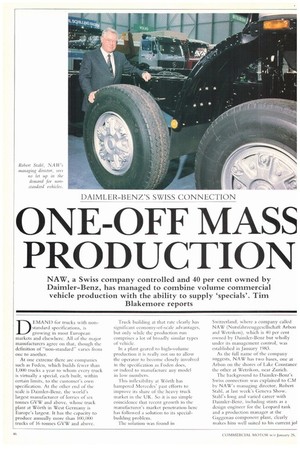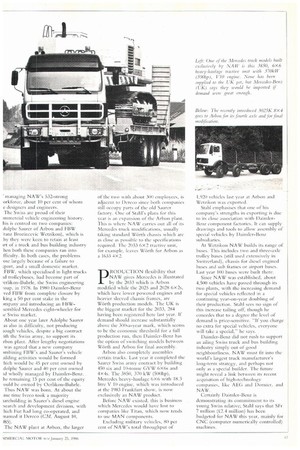ONE-OFF MASS PRODUCTION
Page 46

Page 47

If you've noticed an error in this article please click here to report it so we can fix it.
NAW, a Swiss company controlled and 40 per cent owned by Daimler-Benz, has managed to combine volume commercial vehicle production with the ability to supply 'specials'. Tim Blakemore reports DEMAND for trucks with nonstandard specifications, is growing in most European markets and elsewhere. All of the major manufacturers agree on that, though the definition of "non-standard" varies front one to another.
At one extreme there are companies such as Foden, which builds fewer than 1,000 trucks a year to whom every truck is virtually a special, each built, within certain limits, to the customer's own specification. At the other end of the scale is Daimler-Benz, the world's largest manufacturer of lorries of six tonnes GVW and above, whose truck plant at Worth in West Germany is Europe's largest. It has the capacity to produce annually more than 100,000 trucks of 16 tonnes GVW and above.
Truck building at that rate clearly has significant economy-of-scale advantages, but only while the production run comprises a lot of broadly similar types of vehicle.
In a plant geared to high-volume production it is really not on to allow the operator to become closely involved in the specification as Foden does, or indeed to manufacture any model in low numbers.
This inflexibility at Worth has hampered Mercedes' past efforts to improve its share of the heavy truck market in the UK. So it is no simple coincidence that recent growth in the manufacturer's market penetration here has followed a solution to its specialbuilding problem.
The solittion was found in Switzerland, where a company called NAW (Nutsfahrzeuggesellschaft Arbon and Wetzikon), which is 40 per cent owned by Daimler-Benz but wholly under its management control, was established in January 1983.
As the full name of the company suggests, NAW has two bases, one at Arbon on the shores of Lake Constance the other at Wetzikon, near Zurich.
The background to Daimler-Benz's Swiss connection was explained to CM by NAW's managing director, Robert Stahl, at last week's Geneva Show. Stahl's long and varied career with Daimler-Benz, including stints as a design engineer for the Leopard tank and a production manager at the Gaggenau component plant, clearly makes hint well suited to his current jol managing NAW's 532-strong orkfbrce, about 10 per cent of whom e designers and engineers.
The Swiss are proud of their immercial vehicle engineering history. his is centred on two companies: dolphe Saurer of Arbon and FBW 'ranz Brozincevic Wetzikon), which is by they were keen to retain at least trt of a truck and bus building industry hen both these companies ran into fficulty. In both cases, the problems 'ose largely because of a failure to Tort, and a small domestic market. FBW, which specialised in light trucks id trolleybuses, had become part of lerlikon-Buhrle, the Swiss engineering oup. in 1978. In 1980 Daimler-Benz ved FBW from complete closure by king a 50 per cent stake in the impany and introducing an FBWsembled Mercedes eight-wheeler for Le Swiss market.
About one year later Adolphe Sauter as also in difficulty, hot producing lough vehicles, despite a big contract ith the Swiss army, to support its rbon plant. After lengthy negotiations was agreed that a new company )mbining FBW's and Saurer's vehicle Acting activities would be formed 'hich would be 45 per cent owned by dolphe Sauter and 40 per cent owned id wholly managed by Daimler-Benz.. he remaining 15 per cent of the equity • ould be owned by Oerlikon-Buhrle. Thus NAW was born. At about the [me time Iveco took a majority iareholding in Saurer's diesel engine search and development division, with 'Inch Fiat had long co-operated, and !named it Dereco (CM, August 10, )85).
The NAW plant at Arbon, the larger of the two with :Mout 300 employees, is adjacent to Ukreco since both companies still occupy parts of the old Saurer factory. One of Stahl's plans for this year is an expansion of the Arbon plant. This is where NA W carries out all of its Mercedes truck modifications, usually taking standard Worth chassis which are as close as possible to the specifications required. The 2033 6X2 tractive unit, for example, leaves Wiirth for Arbon as a 1633 4x2.
pRODUCTION flexibility that NAW gives Mercedes is illustrated by the 2033 which is Arbon modified while the 2025 and 2028 ox 2s, which have lower powered engines and heavier sleeved chassis frames, arc Worth production models. The UK is the biggest market tbr the 2033, 284 having been registered here last year. if demand should increase substantially above the 300-a-year mark, which seems to be the economic threshold tbr a full production run, then Daimler-Benz has the option of switching models between Worth and Arbon for final assembly.
Arbon also completely assembles certain trucks. Last year it completed the Sauer Swiss army contract by building 450 six and 10-tonne GVW 6x6s anti 4x4s. The 3850, 370 kW (500hp). Mercedes heavy-haulage 6x6 with 18.3 litre V 10 engine, which was introduced at the 1983 Frankfurt show, is now exclusively an NAW product.
Before NAW existed, this is business which Mercedes would have lost to companies like Titan, which now tends to use MAN components.
Excluding military vehicles, 80 per cent of NAW's total throughput of 1,920 vehicles last year at Arbon and Wetzikon was exported.
Stahl emphasises that one of his company's strengths in exporting is due to irs close association with DaimlerBenz component factories. It can supply drawings and tools to allow assembly of special vehicles by Daimler-Benz subsidiaries.
At Wetzikon NAW builds its range of buses. This includes two and three-axle trolley buses (still used extensively in Switzerland), chassis for diesel engined buses and sub frames or airport buses. Last year 100 buses were built there.
Since NAW was established, about 4,500 vehicles have passed through its two plants, with the increasing demand for special vehicles reflected in a continuing year-on-year doubling of their production. Stahl sees no sign of this increase tailing off, though he concedes that to a degree the level of demand is price-sensitive. "11 you charge no extra for special vehicles, everyone will take a special,he says.
Daimier-Benz did not rush to support an ailing Swiss truck and bus building industry simply out of good neighbourliness. NAW must fit into the world's largest truck manufacturer's long-term strategy, and perhaps not only as a special builder. The future • might reveal a link between its recent acquisition of high-technology companies, like AEG and Donner, and NAW.
Certainly Daimler-Benz is demonstrating its commitment to its young Swiss relative; Stahl says that SFr 7 million (0.4 million) has been budgeted for NAW this year, mainly for CNC (computer numerically controlled) machines.


























































